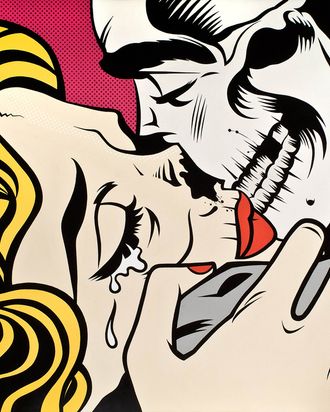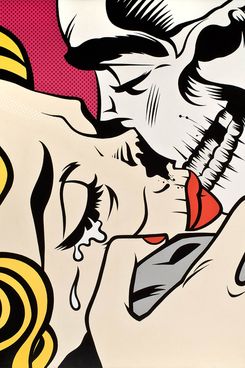D*Face, the U.K.-based street artist, has frequently been touted as the next Banksy, but he waves away the comparison. First of all, heÔÇÖs not as clandestine as Banksy; D*Face allows photographs to be taken of him, though always with something covering his face, be it glasses or a scarf. But he also differentiates his approach: A refugee from the world of advertising, the thirtysomething D*Face (real name Dean Stockton) defines his work as ÔÇ£aPopcalypticÔÇØ: a satirical look at consumerism and our obsession with fame, pop culture, and all things celebrity. And where better to exhibit his dark take on these topics than Los Angeles? The artistÔÇÖs first West Coast solo show, ÔÇ£Going Nowhere Fast,ÔÇØ just opened at L.A.ÔÇÖs Corey Helford Gallery and will be up through mid-May. This multimedia exhibition includes paintings immortalizing decaying versions of Andy Warhol and Michael Jackson, a headstone for Charlie Sheen, and the pi├¿ce de r├®sistance, a painting of the Hollywood sign, singed and burned and sitting atop hundreds of skulls. Click on to see some of his most provocative work from this show, all explained to Vulture by D*Face himself.
This is probably the best wall Ive painted. It embodies everything I try to achieve in my work, particularly work in the public domain  scale, impact, color, sharpness of line, subversion  and most of all, it poses several questions to the viewer: Where are they driving? Why is she looking so relaxed and he so menacing? Is he death, or is she 
These butterflies made from spray cans are a staple of D*FaceÔÇÖs work. ÔÇ£These are a visual metaphor exploring the line between life and death and death and life, the two so closely intertwined that the fragility of our existence is often overshadowed by our trappings of life. I love the idea of a butterfly burning so brightly for such a short period of time.ÔÇØ
Last Friday night at around 3 a.m., D*Face put up this gravestone by SheenÔÇÖs star on the Hollywood Walk of Fame; the police took it down around 8 a.m. (Its current whereabouts are a mystery.) ÔÇ£I like to push the work I put in the street into as many different and as many varied directions as possible. Most of all, I want the publicÔÇÖs reaction to it to be one of shock and awe, getting the viewer to question their relationship with their surroundings and who put it there and why. Gravestones are something that are usually hidden away and confined to graveyards, so the idea of them appearing in central unexpected locations, with slogans that have significance to us all, is something I was sure would raise more than a few eyebrows. With Charlie SheenÔÇÖs current ÔÇÿactivitiesÔÇÖ he was the perfect candidate.ÔÇØ
ÔÇ£IÔÇÖve always loved Pop Art; it was the first art that really spoke to me. Obviously Andy Warhol is the celebrity artist of that generation. The notion of artist [as] celebrity is something that I am personally at odds with; I prefer my work to do the talking, and certainly I donÔÇÖt find what I look like relevant to what my artwork looks like. The work should be judged alone, the complete opposite of what Warhol believed or stood for.ÔÇØ
I looked back through [Roy] Lichtensteins work and referenced who he based his works on  In some cases his rendering was a poor second to the original comic-book art, so with this series of work, I looked through the eyes of Lichtenstein and Tony Abruzzo [and many other famous, legendary comic-book artists] to update and make the images relevant.
ÔÇ£What IÔÇÖve observed in L.A. is that itÔÇÖs a place of contrast, a paradox. On the one hand, itÔÇÖs the sunny, big-blue-skied, white-toothed smile of success; the city of dreams, where ÔÇÿliving the dreamÔÇÖ can be achieved. The flip [side] of that is what happens when the pursuit of this dream doesnÔÇÖt work out. ItÔÇÖs a home for lonely souls.ÔÇØ
ÔÇ£I love the notion of ÔÇÿnever judging a book by its cover.ÔÇÖ Nowhere in the world can that notion be as challenged as in Los Angeles, where every little nuance that makes us all unique and individual can be corrected and ironed out to produce a very off-kilter idea of beauty. These books are visual metaphors for making something new from something thatÔÇÖs passed its ÔÇÿsell byÔÇÖ date.ÔÇØ
For this mobile of hanging knives, ÔÇ£I wanted to bring the idea and perception that graffiti in the public domain is intimidating, [but] bring that intimidation into the safe environment of a gallery. The idea of 200 knives pointing directly at you is also a visual metaphor for ÔÇÿThe Back StabbersÔÇÖ ÔÇö all those people that say how great you are to your face and then say shit about you immediately behind your back.ÔÇØ











